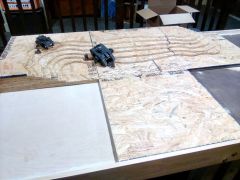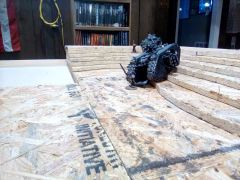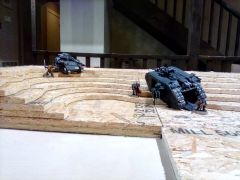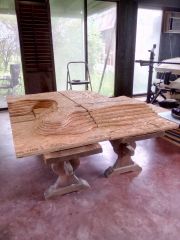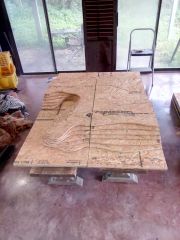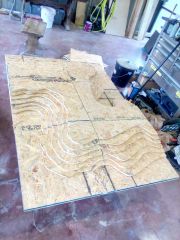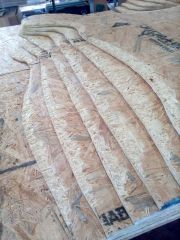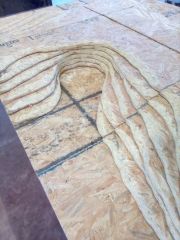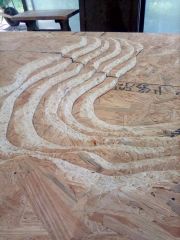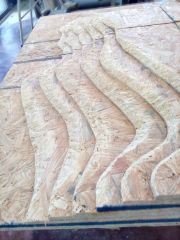Search the Community
Showing results for tags 'modular'.
-
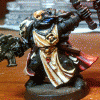
Modular sections 0011
Canadian_F_H posted a gallery image in Terrain, Scenery, Bases, and Game Tables
From the album: CFH Table WIP
Modular tabletop terrain topographical tiles. Made from presswood sheets. nominally 1/2" thick. various degrees of incompletion. tiles are made to line up in as many ways as possible. obviously when the entire edge is at the same elevation. but most importantly every tile edge that has a slope has the same slope profile along the edge. so any piece so long as you orient it properly matching lowland to lowland, and highland to highland, the transition should line up very well. that's the theory. we shall see how it goes. you can see where i have already made a rough pass with a grinder to start to get the smoother shape down. I already tested the slope and models will stand just fine. there will be steeper areas with stepped ledges for models, and that will be difficult terrain and sometimes impassable. also note the early shots with models in for scale. it was entirely intentional that the hills be LOS blocking in certain table arrangements. i thought it would be interesting for games to have LOS blockers that often were not inhibiting movement. the elevated and lower areas will accomodate some other terrain largely dependant on the tile arrangement. ignoring that tiles with duplicate themes (all hill corners or all long hillsides for example) are not actually identical, i already sketched out over 100 permutations of 4 pairs of tiles (2 inside corners, 2 outside corners, 2 long hillsides and 2 flat lowland tiles) when setting up a 4'x6' table. considering swapping each comparable tile with its alternate you can see that the numbers will increase very rapidly. just swapping 2 tiles doubles the permutations. then swapping any other 2 tiles doubles those etc, so in theory over 1600 unique permutations, tho a great many of them will not be extremely different, since the swapping means you really have about 100 arrangements that each have 16 sub variations. throw on terrain etc and you've got more variety than you can shake one of those old red measuring sticks you can't read at. Yes I am aware this is overkill. No it isn't that heavy. Yes it is a lot of work. No i am not crazy. Yes that is exactly what a crazy person would say. -

Modular sections 0010
Canadian_F_H posted a gallery image in Terrain, Scenery, Bases, and Game Tables
From the album: CFH Table WIP
Modular tabletop terrain topographical tiles. Made from presswood sheets. nominally 1/2" thick. various degrees of incompletion. tiles are made to line up in as many ways as possible. obviously when the entire edge is at the same elevation. but most importantly every tile edge that has a slope has the same slope profile along the edge. so any piece so long as you orient it properly matching lowland to lowland, and highland to highland, the transition should line up very well. that's the theory. we shall see how it goes. you can see where i have already made a rough pass with a grinder to start to get the smoother shape down. I already tested the slope and models will stand just fine. there will be steeper areas with stepped ledges for models, and that will be difficult terrain and sometimes impassable. also note the early shots with models in for scale. it was entirely intentional that the hills be LOS blocking in certain table arrangements. i thought it would be interesting for games to have LOS blockers that often were not inhibiting movement. the elevated and lower areas will accomodate some other terrain largely dependant on the tile arrangement. ignoring that tiles with duplicate themes (all hill corners or all long hillsides for example) are not actually identical, i already sketched out over 100 permutations of 4 pairs of tiles (2 inside corners, 2 outside corners, 2 long hillsides and 2 flat lowland tiles) when setting up a 4'x6' table. considering swapping each comparable tile with its alternate you can see that the numbers will increase very rapidly. just swapping 2 tiles doubles the permutations. then swapping any other 2 tiles doubles those etc, so in theory over 1600 unique permutations, tho a great many of them will not be extremely different, since the swapping means you really have about 100 arrangements that each have 16 sub variations. throw on terrain etc and you've got more variety than you can shake one of those old red measuring sticks you can't read at. Yes I am aware this is overkill. No it isn't that heavy. Yes it is a lot of work. No i am not crazy. Yes that is exactly what a crazy person would say. -

Modular sections 0009
Canadian_F_H posted a gallery image in Terrain, Scenery, Bases, and Game Tables
From the album: CFH Table WIP
Modular tabletop terrain topographical tiles. Made from presswood sheets. nominally 1/2" thick. various degrees of incompletion. tiles are made to line up in as many ways as possible. obviously when the entire edge is at the same elevation. but most importantly every tile edge that has a slope has the same slope profile along the edge. so any piece so long as you orient it properly matching lowland to lowland, and highland to highland, the transition should line up very well. that's the theory. we shall see how it goes. you can see where i have already made a rough pass with a grinder to start to get the smoother shape down. I already tested the slope and models will stand just fine. there will be steeper areas with stepped ledges for models, and that will be difficult terrain and sometimes impassable. also note the early shots with models in for scale. it was entirely intentional that the hills be LOS blocking in certain table arrangements. i thought it would be interesting for games to have LOS blockers that often were not inhibiting movement. the elevated and lower areas will accomodate some other terrain largely dependant on the tile arrangement. ignoring that tiles with duplicate themes (all hill corners or all long hillsides for example) are not actually identical, i already sketched out over 100 permutations of 4 pairs of tiles (2 inside corners, 2 outside corners, 2 long hillsides and 2 flat lowland tiles) when setting up a 4'x6' table. considering swapping each comparable tile with its alternate you can see that the numbers will increase very rapidly. just swapping 2 tiles doubles the permutations. then swapping any other 2 tiles doubles those etc, so in theory over 1600 unique permutations, tho a great many of them will not be extremely different, since the swapping means you really have about 100 arrangements that each have 16 sub variations. throw on terrain etc and you've got more variety than you can shake one of those old red measuring sticks you can't read at. Yes I am aware this is overkill. No it isn't that heavy. Yes it is a lot of work. No i am not crazy. Yes that is exactly what a crazy person would say. -

Modular sections 0008
Canadian_F_H posted a gallery image in Terrain, Scenery, Bases, and Game Tables
From the album: CFH Table WIP
Modular tabletop terrain topographical tiles. Made from presswood sheets. nominally 1/2" thick. various degrees of incompletion. tiles are made to line up in as many ways as possible. obviously when the entire edge is at the same elevation. but most importantly every tile edge that has a slope has the same slope profile along the edge. so any piece so long as you orient it properly matching lowland to lowland, and highland to highland, the transition should line up very well. that's the theory. we shall see how it goes. you can see where i have already made a rough pass with a grinder to start to get the smoother shape down. I already tested the slope and models will stand just fine. there will be steeper areas with stepped ledges for models, and that will be difficult terrain and sometimes impassable. also note the early shots with models in for scale. it was entirely intentional that the hills be LOS blocking in certain table arrangements. i thought it would be interesting for games to have LOS blockers that often were not inhibiting movement. the elevated and lower areas will accomodate some other terrain largely dependant on the tile arrangement. ignoring that tiles with duplicate themes (all hill corners or all long hillsides for example) are not actually identical, i already sketched out over 100 permutations of 4 pairs of tiles (2 inside corners, 2 outside corners, 2 long hillsides and 2 flat lowland tiles) when setting up a 4'x6' table. considering swapping each comparable tile with its alternate you can see that the numbers will increase very rapidly. just swapping 2 tiles doubles the permutations. then swapping any other 2 tiles doubles those etc, so in theory over 1600 unique permutations, tho a great many of them will not be extremely different, since the swapping means you really have about 100 arrangements that each have 16 sub variations. throw on terrain etc and you've got more variety than you can shake one of those old red measuring sticks you can't read at. Yes I am aware this is overkill. No it isn't that heavy. Yes it is a lot of work. No i am not crazy. Yes that is exactly what a crazy person would say. -

Modular sections 0007
Canadian_F_H posted a gallery image in Terrain, Scenery, Bases, and Game Tables
From the album: CFH Table WIP
Modular tabletop terrain topographical tiles. Made from presswood sheets. nominally 1/2" thick. various degrees of incompletion. tiles are made to line up in as many ways as possible. obviously when the entire edge is at the same elevation. but most importantly every tile edge that has a slope has the same slope profile along the edge. so any piece so long as you orient it properly matching lowland to lowland, and highland to highland, the transition should line up very well. that's the theory. we shall see how it goes. you can see where i have already made a rough pass with a grinder to start to get the smoother shape down. I already tested the slope and models will stand just fine. there will be steeper areas with stepped ledges for models, and that will be difficult terrain and sometimes impassable. also note the early shots with models in for scale. it was entirely intentional that the hills be LOS blocking in certain table arrangements. i thought it would be interesting for games to have LOS blockers that often were not inhibiting movement. the elevated and lower areas will accomodate some other terrain largely dependant on the tile arrangement. ignoring that tiles with duplicate themes (all hill corners or all long hillsides for example) are not actually identical, i already sketched out over 100 permutations of 4 pairs of tiles (2 inside corners, 2 outside corners, 2 long hillsides and 2 flat lowland tiles) when setting up a 4'x6' table. considering swapping each comparable tile with its alternate you can see that the numbers will increase very rapidly. just swapping 2 tiles doubles the permutations. then swapping any other 2 tiles doubles those etc, so in theory over 1600 unique permutations, tho a great many of them will not be extremely different, since the swapping means you really have about 100 arrangements that each have 16 sub variations. throw on terrain etc and you've got more variety than you can shake one of those old red measuring sticks you can't read at. Yes I am aware this is overkill. No it isn't that heavy. Yes it is a lot of work. No i am not crazy. Yes that is exactly what a crazy person would say. -

Modular sections 0006
Canadian_F_H posted a gallery image in Terrain, Scenery, Bases, and Game Tables
From the album: CFH Table WIP
Modular tabletop terrain topographical tiles. Made from presswood sheets. nominally 1/2" thick. various degrees of incompletion. tiles are made to line up in as many ways as possible. obviously when the entire edge is at the same elevation. but most importantly every tile edge that has a slope has the same slope profile along the edge. so any piece so long as you orient it properly matching lowland to lowland, and highland to highland, the transition should line up very well. that's the theory. we shall see how it goes. you can see where i have already made a rough pass with a grinder to start to get the smoother shape down. I already tested the slope and models will stand just fine. there will be steeper areas with stepped ledges for models, and that will be difficult terrain and sometimes impassable. also note the early shots with models in for scale. it was entirely intentional that the hills be LOS blocking in certain table arrangements. i thought it would be interesting for games to have LOS blockers that often were not inhibiting movement. the elevated and lower areas will accomodate some other terrain largely dependant on the tile arrangement. ignoring that tiles with duplicate themes (all hill corners or all long hillsides for example) are not actually identical, i already sketched out over 100 permutations of 4 pairs of tiles (2 inside corners, 2 outside corners, 2 long hillsides and 2 flat lowland tiles) when setting up a 4'x6' table. considering swapping each comparable tile with its alternate you can see that the numbers will increase very rapidly. just swapping 2 tiles doubles the permutations. then swapping any other 2 tiles doubles those etc, so in theory over 1600 unique permutations, tho a great many of them will not be extremely different, since the swapping means you really have about 100 arrangements that each have 16 sub variations. throw on terrain etc and you've got more variety than you can shake one of those old red measuring sticks you can't read at. Yes I am aware this is overkill. No it isn't that heavy. Yes it is a lot of work. No i am not crazy. Yes that is exactly what a crazy person would say. -

Modular sections 0005
Canadian_F_H posted a gallery image in Terrain, Scenery, Bases, and Game Tables
From the album: CFH Table WIP
Modular tabletop terrain topographical tiles. Made from presswood sheets. nominally 1/2" thick. various degrees of incompletion. tiles are made to line up in as many ways as possible. obviously when the entire edge is at the same elevation. but most importantly every tile edge that has a slope has the same slope profile along the edge. so any piece so long as you orient it properly matching lowland to lowland, and highland to highland, the transition should line up very well. that's the theory. we shall see how it goes. you can see where i have already made a rough pass with a grinder to start to get the smoother shape down. I already tested the slope and models will stand just fine. there will be steeper areas with stepped ledges for models, and that will be difficult terrain and sometimes impassable. also note the early shots with models in for scale. it was entirely intentional that the hills be LOS blocking in certain table arrangements. i thought it would be interesting for games to have LOS blockers that often were not inhibiting movement. the elevated and lower areas will accomodate some other terrain largely dependant on the tile arrangement. ignoring that tiles with duplicate themes (all hill corners or all long hillsides for example) are not actually identical, i already sketched out over 100 permutations of 4 pairs of tiles (2 inside corners, 2 outside corners, 2 long hillsides and 2 flat lowland tiles) when setting up a 4'x6' table. considering swapping each comparable tile with its alternate you can see that the numbers will increase very rapidly. just swapping 2 tiles doubles the permutations. then swapping any other 2 tiles doubles those etc, so in theory over 1600 unique permutations, tho a great many of them will not be extremely different, since the swapping means you really have about 100 arrangements that each have 16 sub variations. throw on terrain etc and you've got more variety than you can shake one of those old red measuring sticks you can't read at. Yes I am aware this is overkill. No it isn't that heavy. Yes it is a lot of work. No i am not crazy. Yes that is exactly what a crazy person would say. -

Modular sections 0004
Canadian_F_H posted a gallery image in Terrain, Scenery, Bases, and Game Tables
From the album: CFH Table WIP
Modular tabletop terrain topographical tiles. Made from presswood sheets. nominally 1/2" thick. various degrees of incompletion. tiles are made to line up in as many ways as possible. obviously when the entire edge is at the same elevation. but most importantly every tile edge that has a slope has the same slope profile along the edge. so any piece so long as you orient it properly matching lowland to lowland, and highland to highland, the transition should line up very well. that's the theory. we shall see how it goes. you can see where i have already made a rough pass with a grinder to start to get the smoother shape down. I already tested the slope and models will stand just fine. there will be steeper areas with stepped ledges for models, and that will be difficult terrain and sometimes impassable. also note the early shots with models in for scale. it was entirely intentional that the hills be LOS blocking in certain table arrangements. i thought it would be interesting for games to have LOS blockers that often were not inhibiting movement. the elevated and lower areas will accomodate some other terrain largely dependant on the tile arrangement. ignoring that tiles with duplicate themes (all hill corners or all long hillsides for example) are not actually identical, i already sketched out over 100 permutations of 4 pairs of tiles (2 inside corners, 2 outside corners, 2 long hillsides and 2 flat lowland tiles) when setting up a 4'x6' table. considering swapping each comparable tile with its alternate you can see that the numbers will increase very rapidly. just swapping 2 tiles doubles the permutations. then swapping any other 2 tiles doubles those etc, so in theory over 1600 unique permutations, tho a great many of them will not be extremely different, since the swapping means you really have about 100 arrangements that each have 16 sub variations. throw on terrain etc and you've got more variety than you can shake one of those old red measuring sticks you can't read at. Yes I am aware this is overkill. No it isn't that heavy. Yes it is a lot of work. No i am not crazy. Yes that is exactly what a crazy person would say. -

Modular sections 0003
Canadian_F_H posted a gallery image in Terrain, Scenery, Bases, and Game Tables
From the album: CFH Table WIP
Modular tabletop terrain topographical tiles. Made from presswood sheets. nominally 1/2" thick. various degrees of incompletion. tiles are made to line up in as many ways as possible. obviously when the entire edge is at the same elevation. but most importantly every tile edge that has a slope has the same slope profile along the edge. so any piece so long as you orient it properly matching lowland to lowland, and highland to highland, the transition should line up very well. that's the theory. we shall see how it goes. you can see where i have already made a rough pass with a grinder to start to get the smoother shape down. I already tested the slope and models will stand just fine. there will be steeper areas with stepped ledges for models, and that will be difficult terrain and sometimes impassable. also note the early shots with models in for scale. it was entirely intentional that the hills be LOS blocking in certain table arrangements. i thought it would be interesting for games to have LOS blockers that often were not inhibiting movement. the elevated and lower areas will accomodate some other terrain largely dependant on the tile arrangement. ignoring that tiles with duplicate themes (all hill corners or all long hillsides for example) are not actually identical, i already sketched out over 100 permutations of 4 pairs of tiles (2 inside corners, 2 outside corners, 2 long hillsides and 2 flat lowland tiles) when setting up a 4'x6' table. considering swapping each comparable tile with its alternate you can see that the numbers will increase very rapidly. just swapping 2 tiles doubles the permutations. then swapping any other 2 tiles doubles those etc, so in theory over 1600 unique permutations, tho a great many of them will not be extremely different, since the swapping means you really have about 100 arrangements that each have 16 sub variations. throw on terrain etc and you've got more variety than you can shake one of those old red measuring sticks you can't read at. Yes I am aware this is overkill. No it isn't that heavy. Yes it is a lot of work. No i am not crazy. Yes that is exactly what a crazy person would say. -

Modular sections 0002
Canadian_F_H posted a gallery image in Terrain, Scenery, Bases, and Game Tables
From the album: CFH Table WIP
Modular tabletop terrain topographical tiles. Made from presswood sheets. nominally 1/2" thick. various degrees of incompletion. tiles are made to line up in as many ways as possible. obviously when the entire edge is at the same elevation. but most importantly every tile edge that has a slope has the same slope profile along the edge. so any piece so long as you orient it properly matching lowland to lowland, and highland to highland, the transition should line up very well. that's the theory. we shall see how it goes. you can see where i have already made a rough pass with a grinder to start to get the smoother shape down. I already tested the slope and models will stand just fine. there will be steeper areas with stepped ledges for models, and that will be difficult terrain and sometimes impassable. also note the early shots with models in for scale. it was entirely intentional that the hills be LOS blocking in certain table arrangements. i thought it would be interesting for games to have LOS blockers that often were not inhibiting movement. the elevated and lower areas will accomodate some other terrain largely dependant on the tile arrangement. ignoring that tiles with duplicate themes (all hill corners or all long hillsides for example) are not actually identical, i already sketched out over 100 permutations of 4 pairs of tiles (2 inside corners, 2 outside corners, 2 long hillsides and 2 flat lowland tiles) when setting up a 4'x6' table. considering swapping each comparable tile with its alternate you can see that the numbers will increase very rapidly. just swapping 2 tiles doubles the permutations. then swapping any other 2 tiles doubles those etc, so in theory over 1600 unique permutations, tho a great many of them will not be extremely different, since the swapping means you really have about 100 arrangements that each have 16 sub variations. throw on terrain etc and you've got more variety than you can shake one of those old red measuring sticks you can't read at. Yes I am aware this is overkill. No it isn't that heavy. Yes it is a lot of work. No i am not crazy. Yes that is exactly what a crazy person would say.

